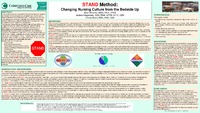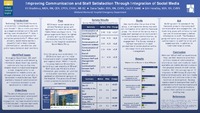| dc.contributor.author | Wharton, Brian | en |
| dc.contributor.author | Kasprenski, Andrea | en |
| dc.contributor.author | Ward, Cherie | en |
| dc.date.accessioned | 2017-12-05T21:28:47Z | |
| dc.date.available | 2017-12-05T21:28:47Z | |
| dc.date.issued | 2017-12-05 | |
| dc.identifier.uri | http://hdl.handle.net/10755/623682 | en |
| dc.description | <p>ENA 2017: Education, Networking, Advocacy. Held at America's Center Convention Center, St. Louis, Missouri</p> | en |
| dc.description.abstract | <p><strong>Purpose:</strong> According to the literature, it is highly recognized that when people are in an environment that fosters growth, encourages diversity and encourages learning, employees become more engaged and have a higher level of dedication. The STAND (Safety, Tolerance, Awareness, Nurturing and Diversity) method is a nontraditional approach to transforming the nursing culture utilizing a change from within, bedside up not the traditional top-down method, with the goal of amending workplace culture to a more positive, accepting and nurturing environment.</p>
<p><strong>Objectives:</strong> Identify current psychological aspects of nursing culture and redefine within our Emergency Department; Create key concepts of changing the current culture and present to staff; Present formal educational sessions including education via critical skills sessions, web education activities, STAND kick-off celebrations, monthly educational celebrations, informal education such as one to one education, and informational sheets available; Benchmark with improvement in employee engagement scores, surveys among registered nurses within the Emergency Department.</p>
<p><strong>Design:</strong> Observational design study is used for the purpose of staff development.</p>
<p><strong>Setting:</strong> The project setting is in a suburban level I trauma center of a teaching hospital.</p>
<p><strong>Participants/Subjects:</strong> Inclusion criteria: Emergency Department registered nurses at Christiana Care Health systems. Exclusion criteria: non-nurse staff members inside the Emergency Department.</p>
<p><strong>Methods:</strong> The creators of the STAND method identified the previous nursing culture which was not in alignment with our hospital’s core values and did not foster the growth of newer nurses and often the “eat your young” motto was adopted by nurses of tenure. The method was developed after a survey from staff concerns, literature review of nursing culture, and a lack of a system that encouraged culture change from the bedside nurse and up. The method was delivered to the staff through critical skills education within the Emergency Department. Evaluation methods include pre and post surveys and employee engagement scores.</p>
<p><strong>Results/Outcomes:</strong> Pre program survey results indicated a strong desire for nursing culture to adapt to new nurses and show flexibility and support. As well, tenured nurses desire high self and peer accountability as well as acknowledgement for diversity and skills that have developed during the nursing career of each nurse. Research is still in progress for post-survey and staff engagement survey scores and should be finalized by March 2017.</p>
<p><strong>Implications:</strong> Recommendations for managers, leaders, nurses, and researchers are: New nurses are entering stressful, extremely chaotic, high capacity environments, where they are expected to have the knowledge and skill set to care for critically ill patients. Experienced nurses are staying at bedside longer, expected to be proficient with new technology, while remaining current in evidence based practices. Nurse Manager’s and administration have the obligation of making a safe place to work and to maintain productivity. Nurses have a unique potential of controlling the environment from the “bottom up.” Research is still in progress. Projected outcomes are that the nurses will grow and thrive in a community where the old nursing culture has been changed to a more positive, accepting, and nurturing culture by using the STAND method.</p> | en |
| dc.format | Text-based Document | en |
| dc.language.iso | en | en |
| dc.subject | Staff Satisfaction | en |
| dc.subject | Nursing Culture | en |
| dc.subject | Emergency Department | en |
| dc.title | STAND Method: Changing nursing culture from the bedside up | en |
| dc.type | Poster | en |
| dc.rights.holder | <p>
All rights reserved by the author(s) and/or publisher(s) listed in this item record unless relinquished in whole or part by a rights notation or a Creative Commons License present in this item record.
</p><p>
All permission requests should be directed accordingly and not to the Sigma Repository.
</p><p>
All submitting authors or publishers have affirmed that when using material in their work where they do not own copyright, they have obtained permission of the copyright holder prior to submission and the rights holder has been acknowledged as necessary.
</p> | en |
| dc.description.note | <p>Items submitted to a conference/event were evaluated/peer-reviewed at the time of abstract submission to the event. No other peer-review was provided prior to submission to the Henderson Repository, unless otherwise noted.</p> | |
| dc.type.category | Full-text | en |
| dc.evidence.level | N/A | en |
| dc.research.approach | N/A | en |
| dc.contributor.department | Non-member | en |
| dc.author.details | Brian Wharton, BSN, RN, CPEN; Andrea Kasprenski, MSN, RN, CEN; Cherie Ward, MSN, RN, CEN | en |
| dc.conference.name | Emergency Nursing 2017 | en |
| dc.conference.host | Emergency Nurses Association | en |
| dc.conference.location | St. Louis, Missouri, USA | en |
| dc.date.conferenceyear | 2017 | |
| dc.description.reviewtype | Abstract Review Only: Reviewed by Event Host | en |
| dc.description.acquisition | Proxy-submission | en |





